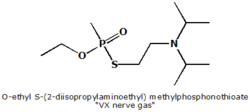VX
|
|
The VX nerve agent is the most well-known of the V-series of nerve agents. Its chemical name is O-ethyl S-(2-diisopropylaminoethyl) methylphosphonothioate.
The only countries known to possess VX are the United States, Russia, France and Syria. VX agent is considered an area denial weapon due to its physical properties.
VX has the texture and feel of high-grade motor oil with its low viscosity, and its low volatility. This makes it especially dangerous, as it has a high persistence in the environment. It works as a nerve agent by blocking the function of the enzyme acetylcholinesterase. Normally, an electric nerve pulse would cause the release of acetylcholine over a synapse that would touch the post-synaptic neuron. This continues the transmission of a nerve signal over the synapse. The excess acetylcholine is then hydrolyzed to non-reactive substances (acetic acid and choline). VX blocks acetylcholinesterase's diffusing properties, thus causing nerves to fire continuously resulting in contractions of all the "involuntary" muscles in the body.
Often regarded as the deadliest nerve agent created to date, as little as 10 mg is enough to kill an average person. Death can be avoided if an autoinjector is used immediately after exposure. Standard chemical agent resistance pills are also effective. The most commonly used antidote in the form of an autoinjector is atropine. Atropine works by binding and blocking a subset of acetylcholine receptors (known as muscarinic acetylcholine receptor, mAchR), so that the build up of acetylcholine produced by loss of the acetylcholinesterase function can no longer affect their target. This prevents involuntary muscle actions and muscles (like the diaphragm and heart) would not be in constant contraction.
A chemist by the name Ranajit Ghosh discovered the V-series nerve agents in Porton Down, England in 1952; the British government later abandoned the project. In 1958 the British government traded their research on VX technology with the United States of America in exchange for information on thermonuclear weapons. The US then went into production of large amounts of VX in 1961. The US later destroyed stockpiles of the deadly nerve agent (by incineration at Johnston Island in the South Pacific), as mandated by the US's accession to the Chemical Weapons Convention. The US is also destroying chemical weapons stockpiles containing VX in nine other locations, of which one of the sites is in Russia. On June 12, 2005, it was reported that more than 250,000 gallons of the chemical weapon are stored at the depot in Newport, Indiana, about 30 miles north of Terre Haute, IN. The VX is in the process of being converted to hydrolysate to destroy it. VX destruction began May 5, 2005 and on June 12 the facility had destroyed 2,894 gallons of VX. A contained spill of 30 gallons drew attention to the disposal process, but authorities said no agent was released and no one was injured in the spill.
A fictional varient of VX, "VX-2" was featured in the 1996 action movie The Rock. For dramatic effect, the movie exaggerated the effects of VX upon its victims, causing the victim's skin to liquify.
External links
- Oxford website on Nerve Gas (http://www.chem.ox.ac.uk/mom/vx/VX.htm)
- Questions and Answers for VX (http://cfrterrorism.org/weapons/vx.html)
- CDC Facts About VX (http://www.bt.cdc.gov/agent/vx/basics/facts.asp)
- U.S. Army's Chemical Materials Agency (CMA) (http://www.cma.army.mil/home.aspx)
- Newport Chemical Agent Destruction Facility spill (http://www.indystar.com/apps/pbcs.dll/article?AID=/20050612/NEWS01/506120405/1008/NEWS02)de:Nervengas VX

